Observation Report on Student with Special Needs
VerifiedAdded on 2022/12/27
|8
|2156
|89
AI Summary
This report is focused on outlining, Steve’s analysis and comparison after observing two differently abled children Lauretta and Seby. Data of Steve’s personal background is also discussed as he was once a student of Lauretta and Seby’s school and was a special child as well. In this observation study, the goal is to understand how the trainees can better groom the differently abled children by observing them and connecting with people who are working with them. Names of the subjects have been changed for the purpose of identity protection.
Contribute Materials
Your contribution can guide someone’s learning journey. Share your
documents today.
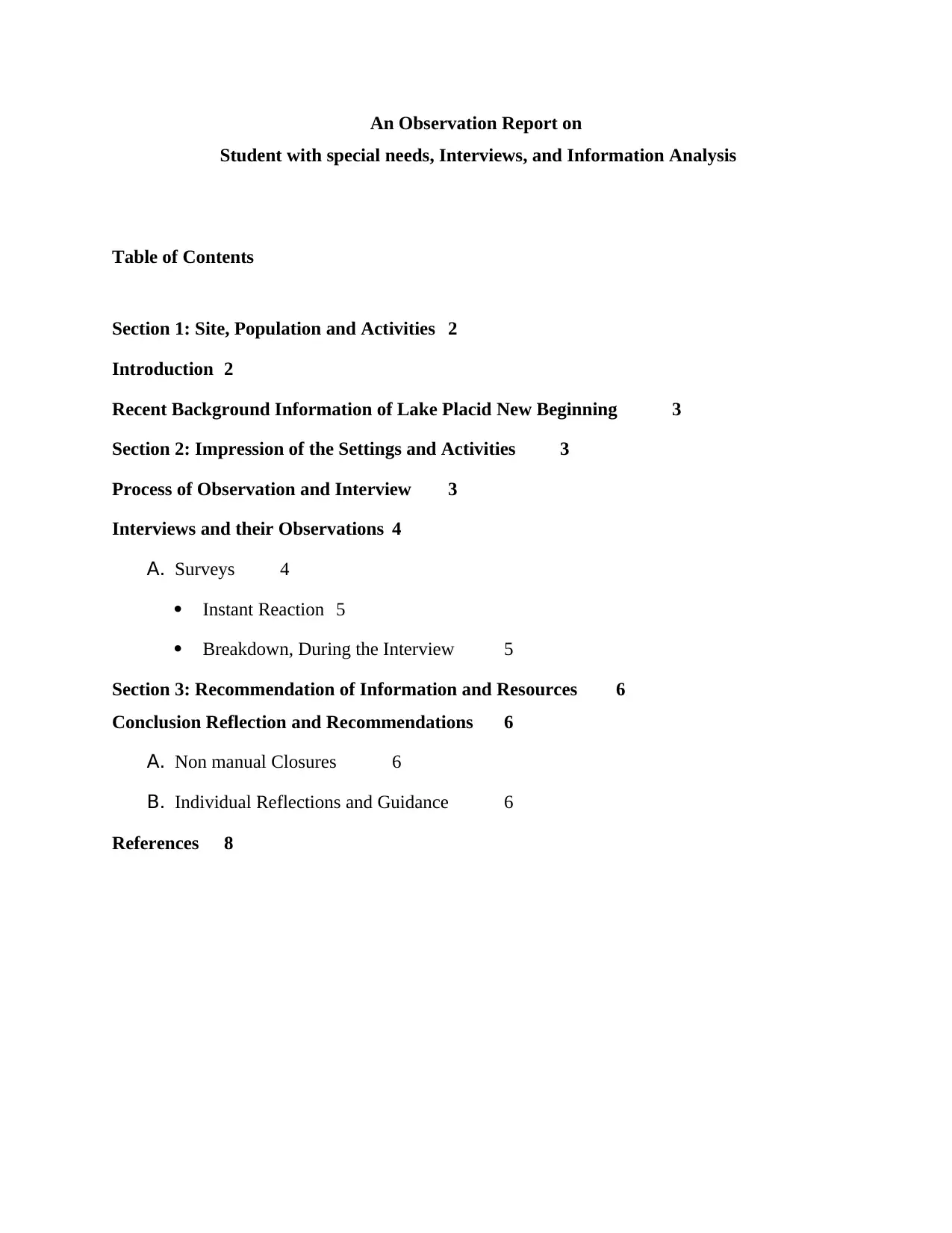
An Observation Report on
Student with special needs, Interviews, and Information Analysis
Table of Contents
Section 1: Site, Population and Activities 2
Introduction 2
Recent Background Information of Lake Placid New Beginning 3
Section 2: Impression of the Settings and Activities 3
Process of Observation and Interview 3
Interviews and their Observations 4
A. Surveys 4
Instant Reaction 5
Breakdown, During the Interview 5
Section 3: Recommendation of Information and Resources 6
Conclusion Reflection and Recommendations 6
A. Non manual Closures 6
B. Individual Reflections and Guidance 6
References 8
Student with special needs, Interviews, and Information Analysis
Table of Contents
Section 1: Site, Population and Activities 2
Introduction 2
Recent Background Information of Lake Placid New Beginning 3
Section 2: Impression of the Settings and Activities 3
Process of Observation and Interview 3
Interviews and their Observations 4
A. Surveys 4
Instant Reaction 5
Breakdown, During the Interview 5
Section 3: Recommendation of Information and Resources 6
Conclusion Reflection and Recommendations 6
A. Non manual Closures 6
B. Individual Reflections and Guidance 6
References 8
Secure Best Marks with AI Grader
Need help grading? Try our AI Grader for instant feedback on your assignments.
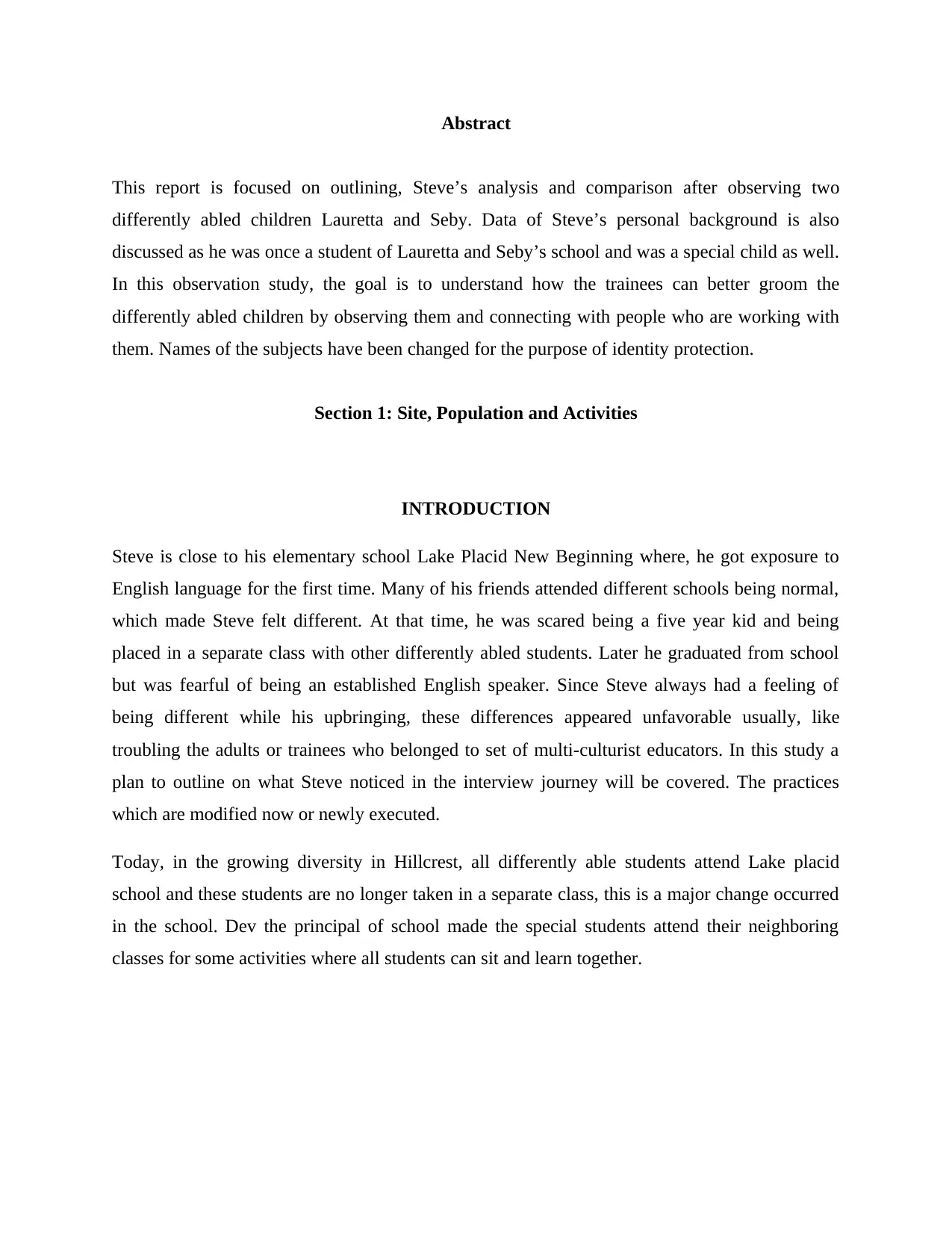
Abstract
This report is focused on outlining, Steve’s analysis and comparison after observing two
differently abled children Lauretta and Seby. Data of Steve’s personal background is also
discussed as he was once a student of Lauretta and Seby’s school and was a special child as well.
In this observation study, the goal is to understand how the trainees can better groom the
differently abled children by observing them and connecting with people who are working with
them. Names of the subjects have been changed for the purpose of identity protection.
Section 1: Site, Population and Activities
INTRODUCTION
Steve is close to his elementary school Lake Placid New Beginning where, he got exposure to
English language for the first time. Many of his friends attended different schools being normal,
which made Steve felt different. At that time, he was scared being a five year kid and being
placed in a separate class with other differently abled students. Later he graduated from school
but was fearful of being an established English speaker. Since Steve always had a feeling of
being different while his upbringing, these differences appeared unfavorable usually, like
troubling the adults or trainees who belonged to set of multi-culturist educators. In this study a
plan to outline on what Steve noticed in the interview journey will be covered. The practices
which are modified now or newly executed.
Today, in the growing diversity in Hillcrest, all differently able students attend Lake placid
school and these students are no longer taken in a separate class, this is a major change occurred
in the school. Dev the principal of school made the special students attend their neighboring
classes for some activities where all students can sit and learn together.
This report is focused on outlining, Steve’s analysis and comparison after observing two
differently abled children Lauretta and Seby. Data of Steve’s personal background is also
discussed as he was once a student of Lauretta and Seby’s school and was a special child as well.
In this observation study, the goal is to understand how the trainees can better groom the
differently abled children by observing them and connecting with people who are working with
them. Names of the subjects have been changed for the purpose of identity protection.
Section 1: Site, Population and Activities
INTRODUCTION
Steve is close to his elementary school Lake Placid New Beginning where, he got exposure to
English language for the first time. Many of his friends attended different schools being normal,
which made Steve felt different. At that time, he was scared being a five year kid and being
placed in a separate class with other differently abled students. Later he graduated from school
but was fearful of being an established English speaker. Since Steve always had a feeling of
being different while his upbringing, these differences appeared unfavorable usually, like
troubling the adults or trainees who belonged to set of multi-culturist educators. In this study a
plan to outline on what Steve noticed in the interview journey will be covered. The practices
which are modified now or newly executed.
Today, in the growing diversity in Hillcrest, all differently able students attend Lake placid
school and these students are no longer taken in a separate class, this is a major change occurred
in the school. Dev the principal of school made the special students attend their neighboring
classes for some activities where all students can sit and learn together.
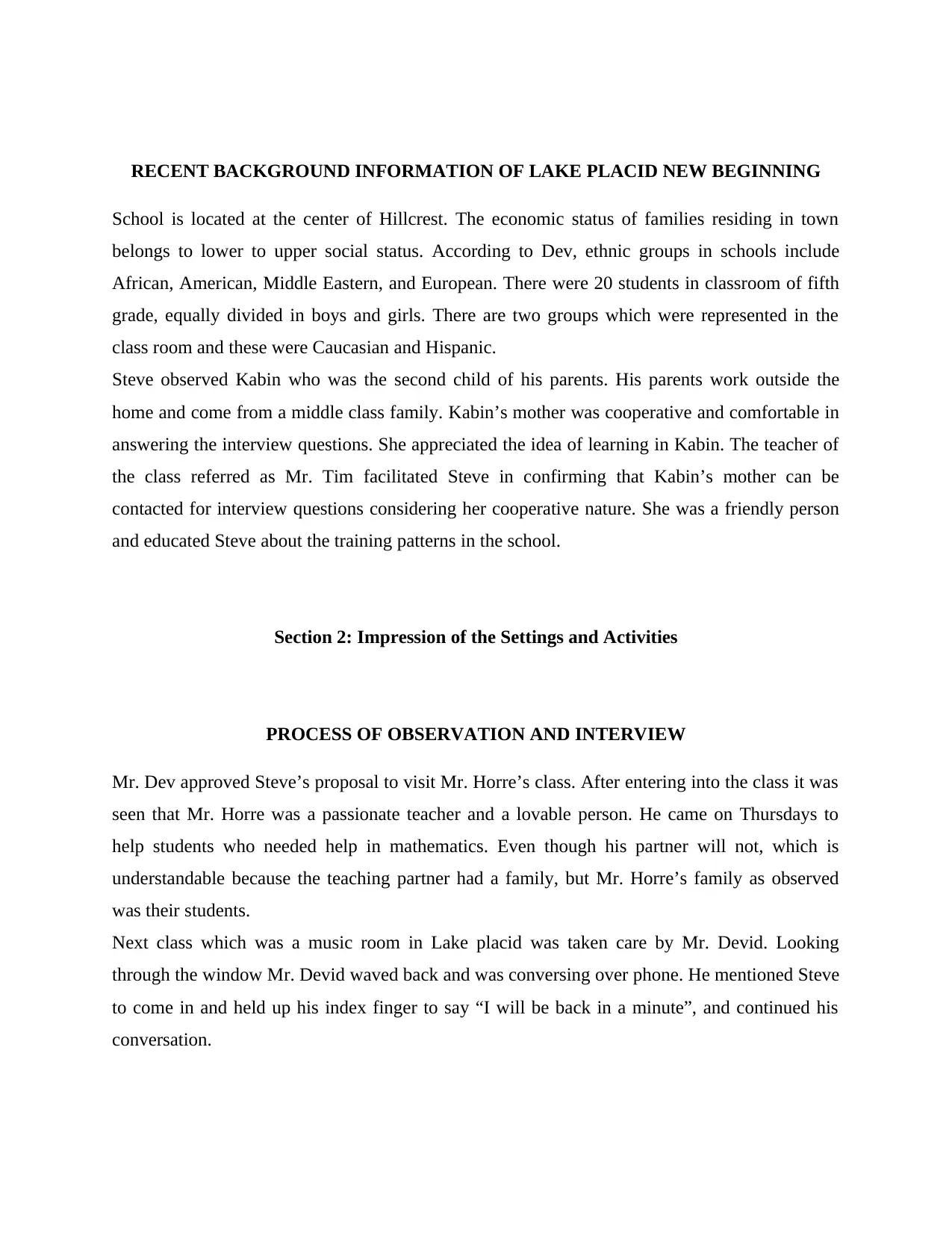
RECENT BACKGROUND INFORMATION OF LAKE PLACID NEW BEGINNING
School is located at the center of Hillcrest. The economic status of families residing in town
belongs to lower to upper social status. According to Dev, ethnic groups in schools include
African, American, Middle Eastern, and European. There were 20 students in classroom of fifth
grade, equally divided in boys and girls. There are two groups which were represented in the
class room and these were Caucasian and Hispanic.
Steve observed Kabin who was the second child of his parents. His parents work outside the
home and come from a middle class family. Kabin’s mother was cooperative and comfortable in
answering the interview questions. She appreciated the idea of learning in Kabin. The teacher of
the class referred as Mr. Tim facilitated Steve in confirming that Kabin’s mother can be
contacted for interview questions considering her cooperative nature. She was a friendly person
and educated Steve about the training patterns in the school.
Section 2: Impression of the Settings and Activities
PROCESS OF OBSERVATION AND INTERVIEW
Mr. Dev approved Steve’s proposal to visit Mr. Horre’s class. After entering into the class it was
seen that Mr. Horre was a passionate teacher and a lovable person. He came on Thursdays to
help students who needed help in mathematics. Even though his partner will not, which is
understandable because the teaching partner had a family, but Mr. Horre’s family as observed
was their students.
Next class which was a music room in Lake placid was taken care by Mr. Devid. Looking
through the window Mr. Devid waved back and was conversing over phone. He mentioned Steve
to come in and held up his index finger to say “I will be back in a minute”, and continued his
conversation.
School is located at the center of Hillcrest. The economic status of families residing in town
belongs to lower to upper social status. According to Dev, ethnic groups in schools include
African, American, Middle Eastern, and European. There were 20 students in classroom of fifth
grade, equally divided in boys and girls. There are two groups which were represented in the
class room and these were Caucasian and Hispanic.
Steve observed Kabin who was the second child of his parents. His parents work outside the
home and come from a middle class family. Kabin’s mother was cooperative and comfortable in
answering the interview questions. She appreciated the idea of learning in Kabin. The teacher of
the class referred as Mr. Tim facilitated Steve in confirming that Kabin’s mother can be
contacted for interview questions considering her cooperative nature. She was a friendly person
and educated Steve about the training patterns in the school.
Section 2: Impression of the Settings and Activities
PROCESS OF OBSERVATION AND INTERVIEW
Mr. Dev approved Steve’s proposal to visit Mr. Horre’s class. After entering into the class it was
seen that Mr. Horre was a passionate teacher and a lovable person. He came on Thursdays to
help students who needed help in mathematics. Even though his partner will not, which is
understandable because the teaching partner had a family, but Mr. Horre’s family as observed
was their students.
Next class which was a music room in Lake placid was taken care by Mr. Devid. Looking
through the window Mr. Devid waved back and was conversing over phone. He mentioned Steve
to come in and held up his index finger to say “I will be back in a minute”, and continued his
conversation.
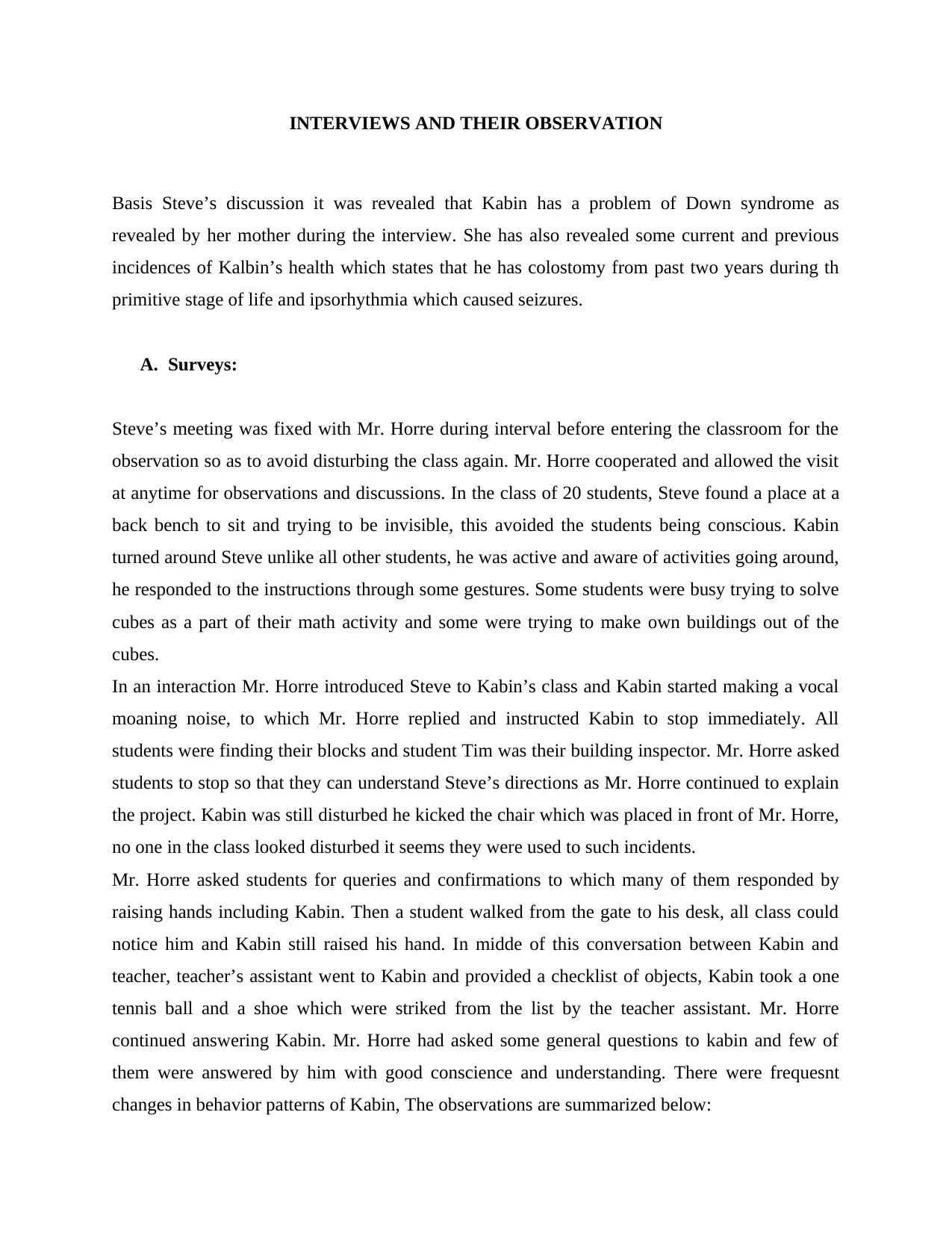
INTERVIEWS AND THEIR OBSERVATION
Basis Steve’s discussion it was revealed that Kabin has a problem of Down syndrome as
revealed by her mother during the interview. She has also revealed some current and previous
incidences of Kalbin’s health which states that he has colostomy from past two years during th
primitive stage of life and ipsorhythmia which caused seizures.
A. Surveys:
Steve’s meeting was fixed with Mr. Horre during interval before entering the classroom for the
observation so as to avoid disturbing the class again. Mr. Horre cooperated and allowed the visit
at anytime for observations and discussions. In the class of 20 students, Steve found a place at a
back bench to sit and trying to be invisible, this avoided the students being conscious. Kabin
turned around Steve unlike all other students, he was active and aware of activities going around,
he responded to the instructions through some gestures. Some students were busy trying to solve
cubes as a part of their math activity and some were trying to make own buildings out of the
cubes.
In an interaction Mr. Horre introduced Steve to Kabin’s class and Kabin started making a vocal
moaning noise, to which Mr. Horre replied and instructed Kabin to stop immediately. All
students were finding their blocks and student Tim was their building inspector. Mr. Horre asked
students to stop so that they can understand Steve’s directions as Mr. Horre continued to explain
the project. Kabin was still disturbed he kicked the chair which was placed in front of Mr. Horre,
no one in the class looked disturbed it seems they were used to such incidents.
Mr. Horre asked students for queries and confirmations to which many of them responded by
raising hands including Kabin. Then a student walked from the gate to his desk, all class could
notice him and Kabin still raised his hand. In midde of this conversation between Kabin and
teacher, teacher’s assistant went to Kabin and provided a checklist of objects, Kabin took a one
tennis ball and a shoe which were striked from the list by the teacher assistant. Mr. Horre
continued answering Kabin. Mr. Horre had asked some general questions to kabin and few of
them were answered by him with good conscience and understanding. There were frequesnt
changes in behavior patterns of Kabin, The observations are summarized below:
Basis Steve’s discussion it was revealed that Kabin has a problem of Down syndrome as
revealed by her mother during the interview. She has also revealed some current and previous
incidences of Kalbin’s health which states that he has colostomy from past two years during th
primitive stage of life and ipsorhythmia which caused seizures.
A. Surveys:
Steve’s meeting was fixed with Mr. Horre during interval before entering the classroom for the
observation so as to avoid disturbing the class again. Mr. Horre cooperated and allowed the visit
at anytime for observations and discussions. In the class of 20 students, Steve found a place at a
back bench to sit and trying to be invisible, this avoided the students being conscious. Kabin
turned around Steve unlike all other students, he was active and aware of activities going around,
he responded to the instructions through some gestures. Some students were busy trying to solve
cubes as a part of their math activity and some were trying to make own buildings out of the
cubes.
In an interaction Mr. Horre introduced Steve to Kabin’s class and Kabin started making a vocal
moaning noise, to which Mr. Horre replied and instructed Kabin to stop immediately. All
students were finding their blocks and student Tim was their building inspector. Mr. Horre asked
students to stop so that they can understand Steve’s directions as Mr. Horre continued to explain
the project. Kabin was still disturbed he kicked the chair which was placed in front of Mr. Horre,
no one in the class looked disturbed it seems they were used to such incidents.
Mr. Horre asked students for queries and confirmations to which many of them responded by
raising hands including Kabin. Then a student walked from the gate to his desk, all class could
notice him and Kabin still raised his hand. In midde of this conversation between Kabin and
teacher, teacher’s assistant went to Kabin and provided a checklist of objects, Kabin took a one
tennis ball and a shoe which were striked from the list by the teacher assistant. Mr. Horre
continued answering Kabin. Mr. Horre had asked some general questions to kabin and few of
them were answered by him with good conscience and understanding. There were frequesnt
changes in behavior patterns of Kabin, The observations are summarized below:
Secure Best Marks with AI Grader
Need help grading? Try our AI Grader for instant feedback on your assignments.
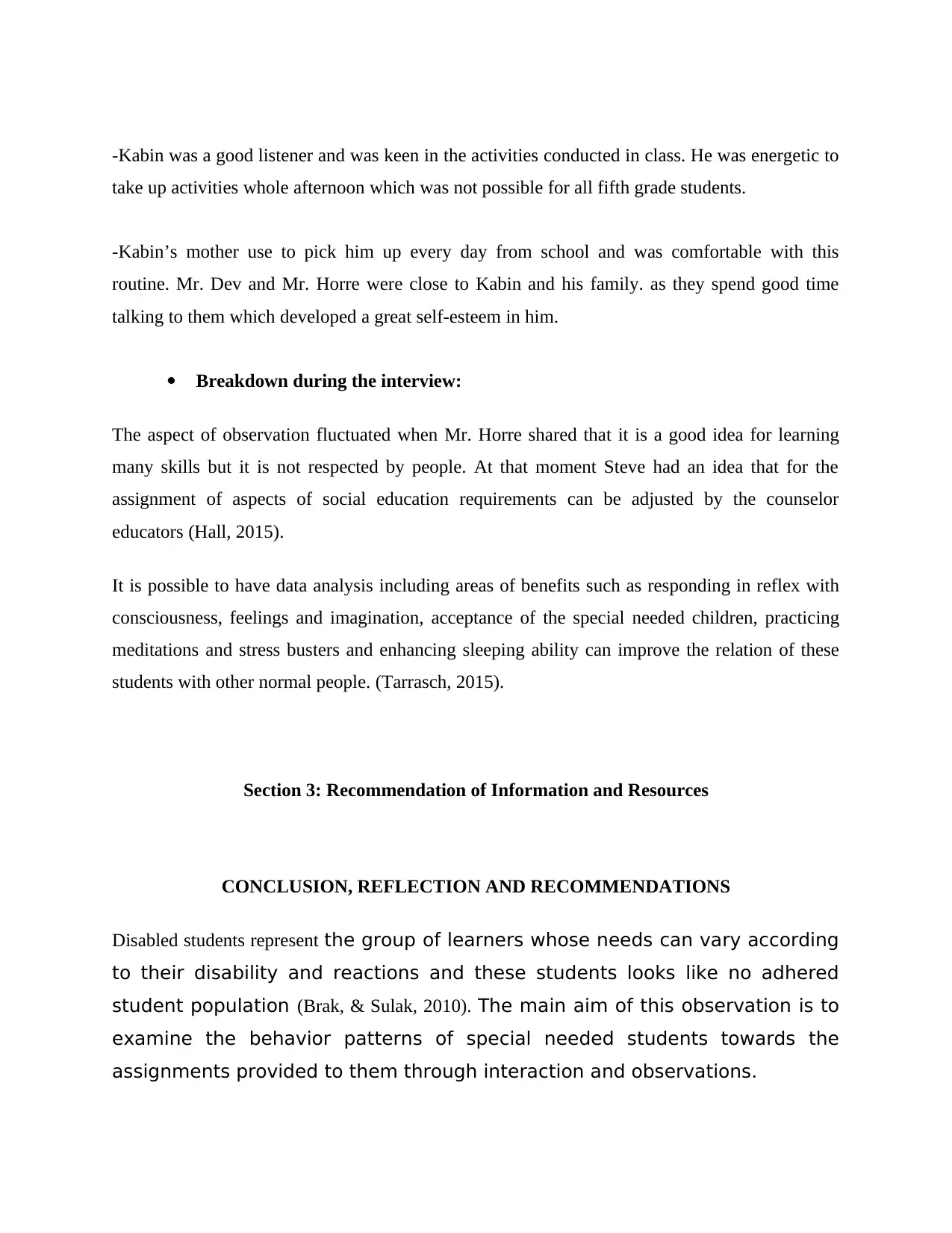
-Kabin was a good listener and was keen in the activities conducted in class. He was energetic to
take up activities whole afternoon which was not possible for all fifth grade students.
-Kabin’s mother use to pick him up every day from school and was comfortable with this
routine. Mr. Dev and Mr. Horre were close to Kabin and his family. as they spend good time
talking to them which developed a great self-esteem in him.
Breakdown during the interview:
The aspect of observation fluctuated when Mr. Horre shared that it is a good idea for learning
many skills but it is not respected by people. At that moment Steve had an idea that for the
assignment of aspects of social education requirements can be adjusted by the counselor
educators (Hall, 2015).
It is possible to have data analysis including areas of benefits such as responding in reflex with
consciousness, feelings and imagination, acceptance of the special needed children, practicing
meditations and stress busters and enhancing sleeping ability can improve the relation of these
students with other normal people. (Tarrasch, 2015).
Section 3: Recommendation of Information and Resources
CONCLUSION, REFLECTION AND RECOMMENDATIONS
Disabled students represent the group of learners whose needs can vary according
to their disability and reactions and these students looks like no adhered
student population (Brak, & Sulak, 2010). The main aim of this observation is to
examine the behavior patterns of special needed students towards the
assignments provided to them through interaction and observations.
take up activities whole afternoon which was not possible for all fifth grade students.
-Kabin’s mother use to pick him up every day from school and was comfortable with this
routine. Mr. Dev and Mr. Horre were close to Kabin and his family. as they spend good time
talking to them which developed a great self-esteem in him.
Breakdown during the interview:
The aspect of observation fluctuated when Mr. Horre shared that it is a good idea for learning
many skills but it is not respected by people. At that moment Steve had an idea that for the
assignment of aspects of social education requirements can be adjusted by the counselor
educators (Hall, 2015).
It is possible to have data analysis including areas of benefits such as responding in reflex with
consciousness, feelings and imagination, acceptance of the special needed children, practicing
meditations and stress busters and enhancing sleeping ability can improve the relation of these
students with other normal people. (Tarrasch, 2015).
Section 3: Recommendation of Information and Resources
CONCLUSION, REFLECTION AND RECOMMENDATIONS
Disabled students represent the group of learners whose needs can vary according
to their disability and reactions and these students looks like no adhered
student population (Brak, & Sulak, 2010). The main aim of this observation is to
examine the behavior patterns of special needed students towards the
assignments provided to them through interaction and observations.
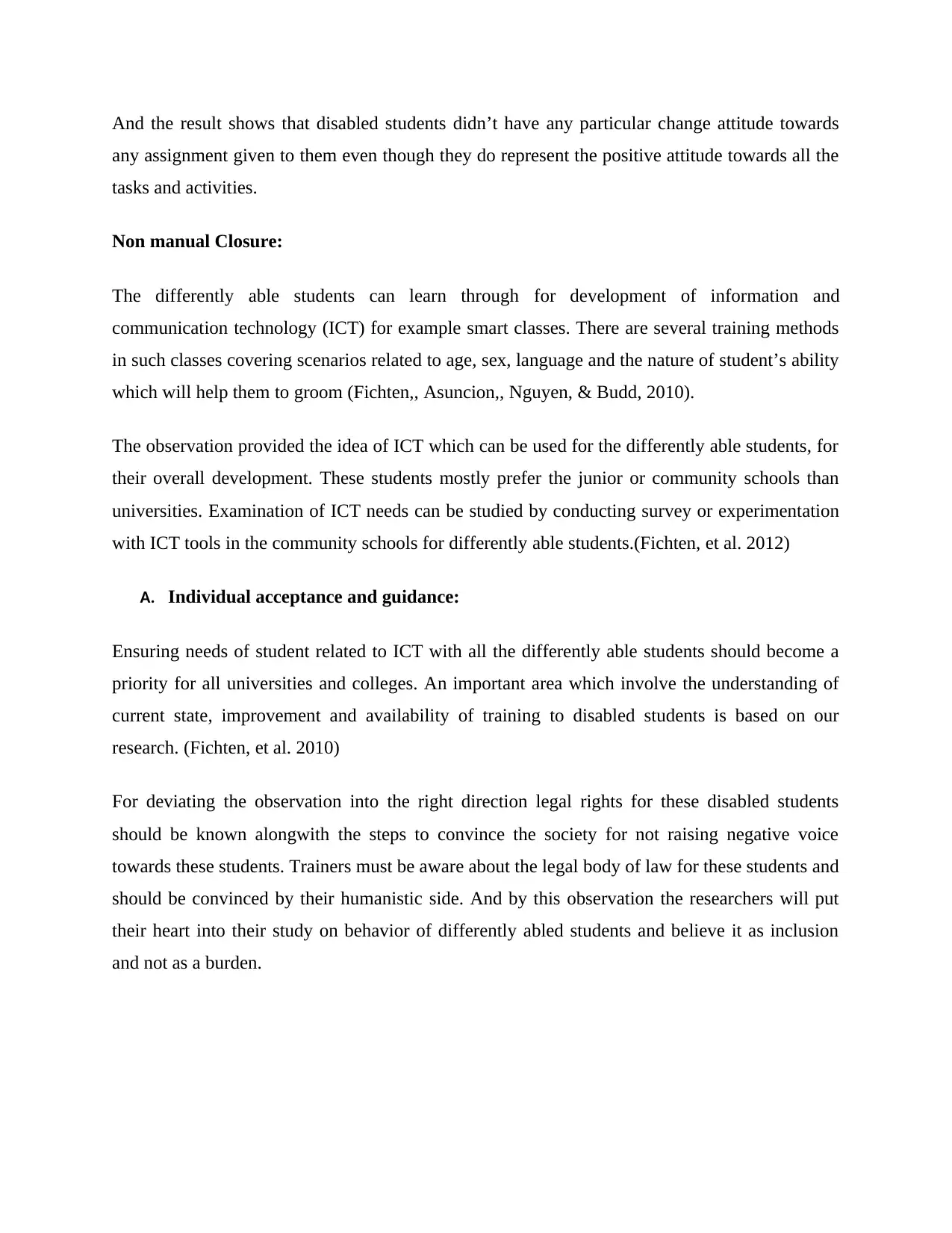
And the result shows that disabled students didn’t have any particular change attitude towards
any assignment given to them even though they do represent the positive attitude towards all the
tasks and activities.
Non manual Closure:
The differently able students can learn through for development of information and
communication technology (ICT) for example smart classes. There are several training methods
in such classes covering scenarios related to age, sex, language and the nature of student’s ability
which will help them to groom (Fichten,, Asuncion,, Nguyen, & Budd, 2010).
The observation provided the idea of ICT which can be used for the differently able students, for
their overall development. These students mostly prefer the junior or community schools than
universities. Examination of ICT needs can be studied by conducting survey or experimentation
with ICT tools in the community schools for differently able students.(Fichten, et al. 2012)
A. Individual acceptance and guidance:
Ensuring needs of student related to ICT with all the differently able students should become a
priority for all universities and colleges. An important area which involve the understanding of
current state, improvement and availability of training to disabled students is based on our
research. (Fichten, et al. 2010)
For deviating the observation into the right direction legal rights for these disabled students
should be known alongwith the steps to convince the society for not raising negative voice
towards these students. Trainers must be aware about the legal body of law for these students and
should be convinced by their humanistic side. And by this observation the researchers will put
their heart into their study on behavior of differently abled students and believe it as inclusion
and not as a burden.
any assignment given to them even though they do represent the positive attitude towards all the
tasks and activities.
Non manual Closure:
The differently able students can learn through for development of information and
communication technology (ICT) for example smart classes. There are several training methods
in such classes covering scenarios related to age, sex, language and the nature of student’s ability
which will help them to groom (Fichten,, Asuncion,, Nguyen, & Budd, 2010).
The observation provided the idea of ICT which can be used for the differently able students, for
their overall development. These students mostly prefer the junior or community schools than
universities. Examination of ICT needs can be studied by conducting survey or experimentation
with ICT tools in the community schools for differently able students.(Fichten, et al. 2012)
A. Individual acceptance and guidance:
Ensuring needs of student related to ICT with all the differently able students should become a
priority for all universities and colleges. An important area which involve the understanding of
current state, improvement and availability of training to disabled students is based on our
research. (Fichten, et al. 2010)
For deviating the observation into the right direction legal rights for these disabled students
should be known alongwith the steps to convince the society for not raising negative voice
towards these students. Trainers must be aware about the legal body of law for these students and
should be convinced by their humanistic side. And by this observation the researchers will put
their heart into their study on behavior of differently abled students and believe it as inclusion
and not as a burden.
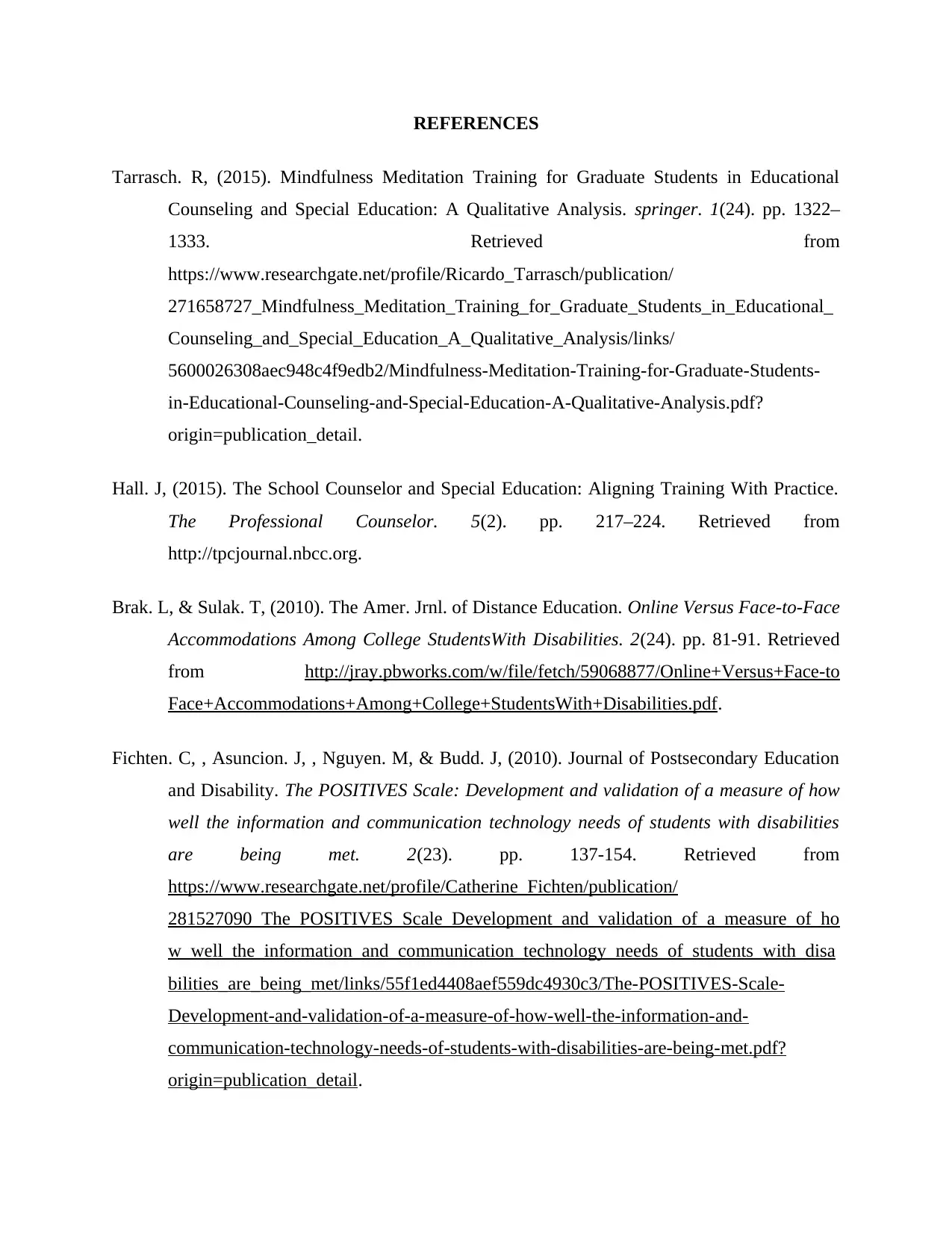
REFERENCES
Tarrasch. R, (2015). Mindfulness Meditation Training for Graduate Students in Educational
Counseling and Special Education: A Qualitative Analysis. springer. 1(24). pp. 1322–
1333. Retrieved from
https://www.researchgate.net/profile/Ricardo_Tarrasch/publication/
271658727_Mindfulness_Meditation_Training_for_Graduate_Students_in_Educational_
Counseling_and_Special_Education_A_Qualitative_Analysis/links/
5600026308aec948c4f9edb2/Mindfulness-Meditation-Training-for-Graduate-Students-
in-Educational-Counseling-and-Special-Education-A-Qualitative-Analysis.pdf?
origin=publication_detail.
Hall. J, (2015). The School Counselor and Special Education: Aligning Training With Practice.
The Professional Counselor. 5(2). pp. 217–224. Retrieved from
http://tpcjournal.nbcc.org.
Brak. L, & Sulak. T, (2010). The Amer. Jrnl. of Distance Education. Online Versus Face-to-Face
Accommodations Among College StudentsWith Disabilities. 2(24). pp. 81-91. Retrieved
from http://jray.pbworks.com/w/file/fetch/59068877/Online+Versus+Face-to
Face+Accommodations+Among+College+StudentsWith+Disabilities.pdf.
Fichten. C, , Asuncion. J, , Nguyen. M, & Budd. J, (2010). Journal of Postsecondary Education
and Disability. The POSITIVES Scale: Development and validation of a measure of how
well the information and communication technology needs of students with disabilities
are being met. 2(23). pp. 137-154. Retrieved from
https://www.researchgate.net/profile/Catherine_Fichten/publication/
281527090_The_POSITIVES_Scale_Development_and_validation_of_a_measure_of_ho
w_well_the_information_and_communication_technology_needs_of_students_with_disa
bilities_are_being_met/links/55f1ed4408aef559dc4930c3/The-POSITIVES-Scale-
Development-and-validation-of-a-measure-of-how-well-the-information-and-
communication-technology-needs-of-students-with-disabilities-are-being-met.pdf?
origin=publication_detail.
Tarrasch. R, (2015). Mindfulness Meditation Training for Graduate Students in Educational
Counseling and Special Education: A Qualitative Analysis. springer. 1(24). pp. 1322–
1333. Retrieved from
https://www.researchgate.net/profile/Ricardo_Tarrasch/publication/
271658727_Mindfulness_Meditation_Training_for_Graduate_Students_in_Educational_
Counseling_and_Special_Education_A_Qualitative_Analysis/links/
5600026308aec948c4f9edb2/Mindfulness-Meditation-Training-for-Graduate-Students-
in-Educational-Counseling-and-Special-Education-A-Qualitative-Analysis.pdf?
origin=publication_detail.
Hall. J, (2015). The School Counselor and Special Education: Aligning Training With Practice.
The Professional Counselor. 5(2). pp. 217–224. Retrieved from
http://tpcjournal.nbcc.org.
Brak. L, & Sulak. T, (2010). The Amer. Jrnl. of Distance Education. Online Versus Face-to-Face
Accommodations Among College StudentsWith Disabilities. 2(24). pp. 81-91. Retrieved
from http://jray.pbworks.com/w/file/fetch/59068877/Online+Versus+Face-to
Face+Accommodations+Among+College+StudentsWith+Disabilities.pdf.
Fichten. C, , Asuncion. J, , Nguyen. M, & Budd. J, (2010). Journal of Postsecondary Education
and Disability. The POSITIVES Scale: Development and validation of a measure of how
well the information and communication technology needs of students with disabilities
are being met. 2(23). pp. 137-154. Retrieved from
https://www.researchgate.net/profile/Catherine_Fichten/publication/
281527090_The_POSITIVES_Scale_Development_and_validation_of_a_measure_of_ho
w_well_the_information_and_communication_technology_needs_of_students_with_disa
bilities_are_being_met/links/55f1ed4408aef559dc4930c3/The-POSITIVES-Scale-
Development-and-validation-of-a-measure-of-how-well-the-information-and-
communication-technology-needs-of-students-with-disabilities-are-being-met.pdf?
origin=publication_detail.
Paraphrase This Document
Need a fresh take? Get an instant paraphrase of this document with our AI Paraphraser
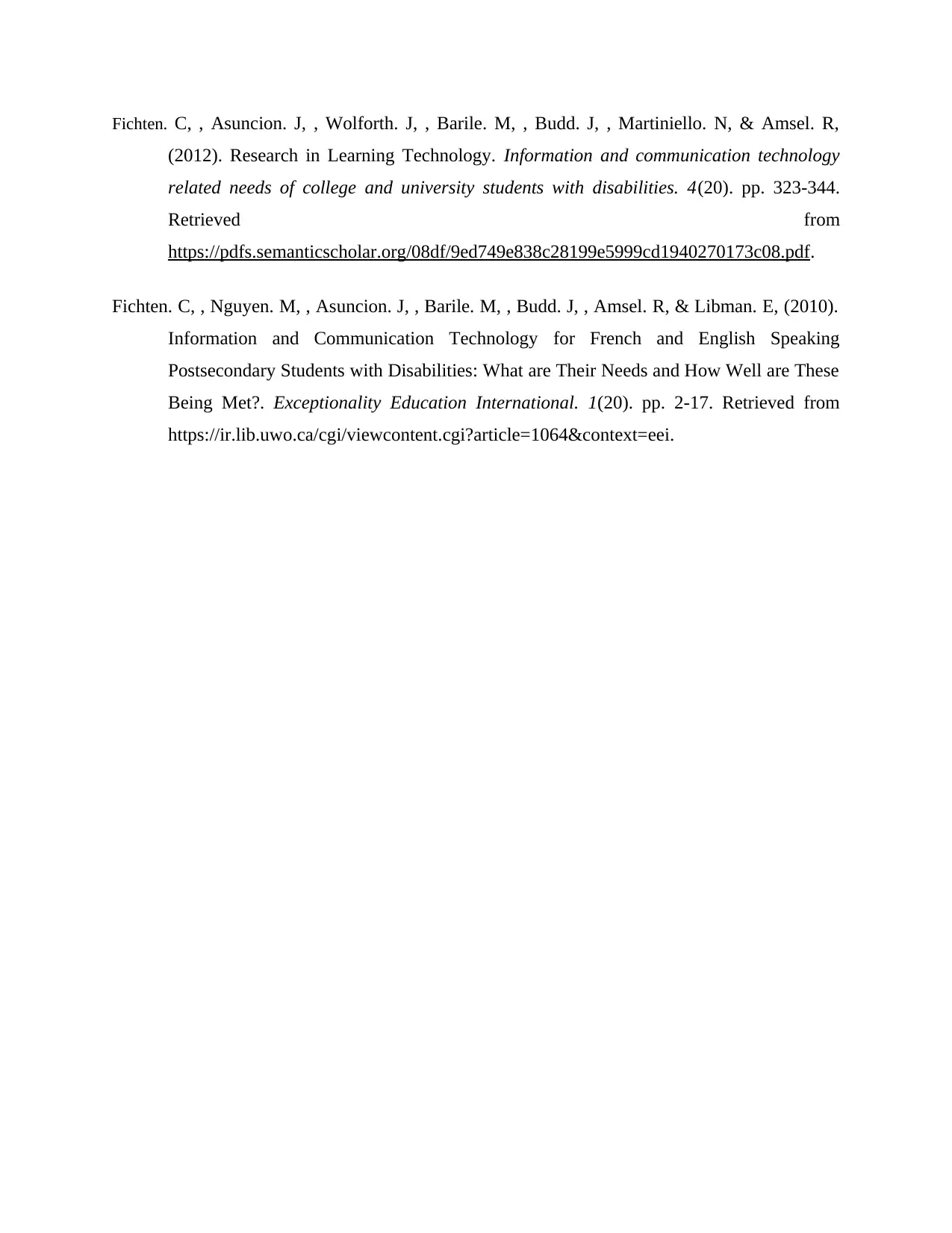
Fichten. C, , Asuncion. J, , Wolforth. J, , Barile. M, , Budd. J, , Martiniello. N, & Amsel. R,
(2012). Research in Learning Technology. Information and communication technology
related needs of college and university students with disabilities. 4(20). pp. 323-344.
Retrieved from
https://pdfs.semanticscholar.org/08df/9ed749e838c28199e5999cd1940270173c08.pdf.
Fichten. C, , Nguyen. M, , Asuncion. J, , Barile. M, , Budd. J, , Amsel. R, & Libman. E, (2010).
Information and Communication Technology for French and English Speaking
Postsecondary Students with Disabilities: What are Their Needs and How Well are These
Being Met?. Exceptionality Education International. 1(20). pp. 2-17. Retrieved from
https://ir.lib.uwo.ca/cgi/viewcontent.cgi?article=1064&context=eei.
(2012). Research in Learning Technology. Information and communication technology
related needs of college and university students with disabilities. 4(20). pp. 323-344.
Retrieved from
https://pdfs.semanticscholar.org/08df/9ed749e838c28199e5999cd1940270173c08.pdf.
Fichten. C, , Nguyen. M, , Asuncion. J, , Barile. M, , Budd. J, , Amsel. R, & Libman. E, (2010).
Information and Communication Technology for French and English Speaking
Postsecondary Students with Disabilities: What are Their Needs and How Well are These
Being Met?. Exceptionality Education International. 1(20). pp. 2-17. Retrieved from
https://ir.lib.uwo.ca/cgi/viewcontent.cgi?article=1064&context=eei.
1 out of 8
Your All-in-One AI-Powered Toolkit for Academic Success.
+13062052269
info@desklib.com
Available 24*7 on WhatsApp / Email
![[object Object]](/_next/static/media/star-bottom.7253800d.svg)
Unlock your academic potential
© 2024 | Zucol Services PVT LTD | All rights reserved.


![[SOLVED] DAS Part 1](/_next/image/?url=https%3A%2F%2Fdesklib.com%2Fmedia%2Fimages%2Fzp%2Ff4f257ef6ae6449984110de5e9c9cbe0.jpg&w=256&q=75)